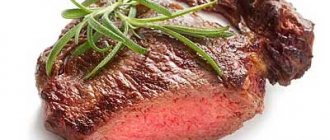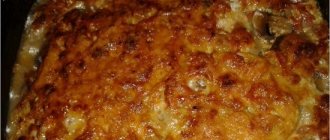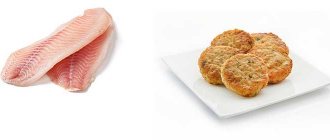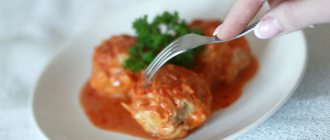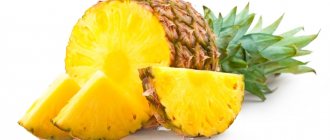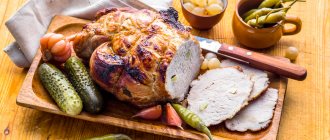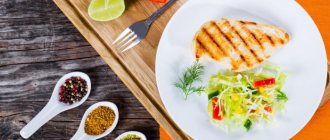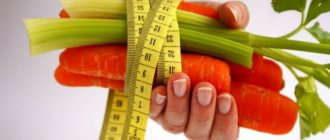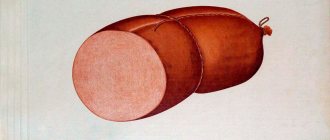Product calorie analysis
SHARE OF BZHU IN CALORIES
Ratio of proteins, fats and carbohydrates:
Knowing the contribution of proteins, fats and carbohydrates to calorie content, you can understand how well a product or diet meets the standards of a healthy diet or the requirements of a certain diet. For example, the US and Russian Departments of Health recommend 10-12% of calories come from protein, 30% from fat and 58-60% from carbohydrates. The Atkins diet recommends low carbohydrate intake, although other diets focus on low fat intake.
If more energy is expended than it is received, the body begins to use up fat reserves, and body weight decreases.
Try filling out your food diary right now without registration.
Find out your additional calorie expenditure for training and get updated recommendations absolutely free.
DATE FOR ACHIEVEMENT OF THE GOAL
Lamb [PRODUCT REMOVED]
rich in vitamins and minerals such as: choline - 14%, vitamin B6 - 20%, vitamin B12 - 66.7%, vitamin PP - 26%, phosphorus - 22.3%, iron - 11.1%, cobalt - 70 %, copper - 18%, molybdenum - 17.1%, chromium - 20%, zinc - 25%
- Choline
is part of lecithin, plays a role in the synthesis and metabolism of phospholipids in the liver, is a source of free methyl groups, and acts as a lipotropic factor. - Vitamin B6
is involved in maintaining the immune response, processes of inhibition and excitation in the central nervous system, in the transformation of amino acids, the metabolism of tryptophan, lipids and nucleic acids, promotes the normal formation of red blood cells, and maintaining normal levels of homocysteine in the blood. Insufficient intake of vitamin B6 is accompanied by decreased appetite, impaired skin condition, and the development of homocysteinemia and anemia. - Vitamin B12
plays an important role in the metabolism and transformation of amino acids. Folate and vitamin B12 are interconnected vitamins that are involved in hematopoiesis. A lack of vitamin B12 leads to the development of partial or secondary folate deficiency, as well as anemia, leukopenia, and thrombocytopenia. - Vitamin PP
is involved in redox reactions of energy metabolism. Insufficient vitamin intake is accompanied by disruption of the normal condition of the skin, gastrointestinal tract and nervous system. - Phosphorus
takes part in many physiological processes, including energy metabolism, regulates acid-base balance, is part of phospholipids, nucleotides and nucleic acids, and is necessary for the mineralization of bones and teeth. Deficiency leads to anorexia, anemia, and rickets. - Iron
is part of proteins with various functions, including enzymes. Participates in the transport of electrons and oxygen, ensures the occurrence of redox reactions and activation of peroxidation. Insufficient consumption leads to hypochromic anemia, myoglobin deficiency atony of skeletal muscles, increased fatigue, myocardiopathy, and atrophic gastritis. - Cobalt
is part of vitamin B12. Activates enzymes of fatty acid metabolism and folic acid metabolism. - Copper
is part of enzymes that have redox activity and are involved in the metabolism of iron, stimulates the absorption of proteins and carbohydrates. Participates in the processes of providing oxygen to the tissues of the human body. Deficiency is manifested by disturbances in the formation of the cardiovascular system and skeleton, and the development of connective tissue dysplasia. - Molybdenum
is a cofactor for many enzymes that ensure the metabolism of sulfur-containing amino acids, purines and pyrimidines. - Chromium
is involved in the regulation of blood glucose levels, enhancing the effect of insulin. Deficiency leads to decreased glucose tolerance. - Zinc
is part of more than 300 enzymes and is involved in the processes of synthesis and breakdown of carbohydrates, proteins, fats, nucleic acids and in the regulation of the expression of a number of genes. Insufficient consumption leads to anemia, secondary immunodeficiency, liver cirrhosis, sexual dysfunction, and the presence of fetal malformations. Research in recent years has revealed the ability of high doses of zinc to disrupt the absorption of copper and thereby contribute to the development of anemia.
more hide
You can see the complete directory of the most useful products in the appendix - a set of properties of a food product, the presence of which satisfies a person’s physiological needs for the necessary substances and energy.
Vitamins
, organic substances required in small quantities in the diet of both humans and most vertebrates. Vitamin synthesis is usually carried out by plants, not animals. A person's daily requirement for vitamins is only a few milligrams or micrograms. Unlike inorganic substances, vitamins are destroyed by strong heat. Many vitamins are unstable and are “lost” during cooking or food processing.
Lamb meat is a favorite product of gourmets. Lamb, whose calorie content is 200-300 kcal/100 g, is considered healthy meat. How many calories are in What beneficial properties does this product have? The nuances of cooking meat, as well as its calorie content in finished form, are given below.
Is lamb harmful to the human body or does it only have benefits?
Lamb has one and a half times less fat than pork tenderloin. This feature provides an opportunity to consume this healthy meat for people who are overweight.
Due to its low fat content, lamb also has low cholesterol levels. The product contains a high content of B vitamins, tocopherol, vitamin D and K.
There are also a lot of minerals in lamb; magnesium, calcium, zinc, sodium and others are found in large quantities.
The amount of BJU and calories per 100 g of product are given in the tables. All indicators are indicated depending on the type of product processing.
| Proteins, g | Fats, g | Carbohydrates, g | Calories, kcal | |
| For a couple | 21,7 | 7,2 | 0,8 | 156,0 |
| Stewed | 18,8 | 18,3 | 0,6 | 240,2 |
| Boiled | 23,0 | 20,0 | 1,4 | 272,7 |
| In the oven | 16,3 | 15,3 | 0,4 | 203,0 |
| Fried | 20,3 | 22,8 | 1,1 | 301,4 |
The benefits of lamb for the human body are quite extensive. The balanced content of macro- and microelements in meat makes this product a healthy delicacy.
Due to its low calorie content, meat is recommended for people suffering from excess weight. It is regularly included in the diet of many girls who are losing weight.
Since there is little fat, cholesterol is present in small quantities, while tocopherol, vitamin D and K are present in large quantities. This means that meat is beneficial for patients who suffer from atherosclerosis and diseases of the cardiovascular system.
The presence of B vitamins has a positive effect on the functioning of the digestive system. They speed up metabolism, tone up and take part in the synthesis of nutrients.
Folic acid (vitamin B9) helps strengthen the immune system.
Other advantages and useful properties include:
- Normalization of the nervous system due to the content of B vitamins.
- Reduces the symptoms of colds.
- Prevents the formation of caries due to the content of fluoride and calcium in large quantities.
- Increases hemoglobin levels due to iron content.
Lamb has a positive effect on the male body. The zinc content in meat promotes the formation of testosterone and increases potency.
For women, this product is useful, first of all, because it is low in calories. You can eat meat and not worry about being overweight. In addition, lamb promotes rapid metabolism.
Navaga: beneficial properties and calorie content
Lamb is rich in folic acid (vitamin B9). This element has a positive effect on the development of the fetus according to the term, and also forms nerve cells. Therefore, sheep meat is recommended for women during pregnancy.
Mothers who are breastfeeding their baby should be careful when including lamb in their diet. Despite all the positive properties, meat can be dangerous for the baby. These are mainly colic, bowel dysfunction and bloating. Therefore, you should take a responsible approach to consuming lamb while breastfeeding.
Important! If you decide to eat lamb during breastfeeding, then this should be done gradually, starting with a less fatty variety.
If the baby does not experience an allergic reaction, then lamb is continued to be administered. If the reaction is negative, then exclude this product from the diet.
Pediatricians recommend introducing lamb into the diet of babies when they reach 1 year of age. This needs to be done gradually. First, offer the baby half a teaspoon. If the reaction is positive, then increase the portion to a whole spoon. It is important to remember that lamb should be given no more than 2 times a week.
Benefits for children:
- reduced risk of developing atherosclerosis due to minimal cholesterol content;
- due to lecithin, the digestive system is activated and muscle cells develop;
- high content of vitamins and minerals, as well as iron, which is responsible for the formation of hemoglobin;
- the presence of fluoride in meat helps prevent the development of caries.
The amount of meat per day for a person depends on gender, age and protein intake:
- for women – 40 g of protein per day;
- men – 50 g of protein per day;
- children – 25-30 g of protein per day;
- elderly – 30 g of protein per day.
Considering that sheep meat contains from 14 to 25% animal protein, then after making simple calculations, we can come to the following conclusion:
- women – 130-150 g of meat per day;
- men – 150-180 g;
- children and elderly - up to 100 g.
Advice! In addition to meat, the menu of a healthy person must include vegetarian and fish dishes.
Lamb meat contains a large amount of minerals and vitamins that have a beneficial effect on the entire body. This product is useful not only for maintaining the normal functioning of all systems, but for the prevention and treatment of certain diseases.
For diabetes
Eating lamb for diabetes is a controversial issue. Most experts say that you can eat meat, and here's why:
- the product activates the functioning of the pancreas;
- lamb has anti-sclerotic properties and can also normalize the amount of cholesterol in the body;
- strengthens the cardiovascular system and participates in the process of hematopoiesis.
For gout
Doctors do not recommend eating lamb for patients suffering from gout. The fact is that meat has high acidity. This leads to an exacerbation of the disease.
For pancreatitis
If you have pancreatitis, this product should also not be consumed due to the presence of fat. Despite the low content of this element, it is very different from the fat of other types of meat:
- high content of saturated fatty acids;
- refractory;
- Digestion requires large amounts of digestive enzymes.
READ MORE: Freshly squeezed juices can be dangerous. Who should not drink and which ones?
Macrurus: benefits and harm, how to cook
However, it is not necessary to completely abandon this product. And that's why:
- complete protein is present;
- low content of extractive elements;
- source of easily digestible iron;
- low calorie content;
- acceptable purine content.
Every girl has been on a grueling diet at least once in her life. Many people suffer from excess weight and constantly adhere to strict diets. The advantage of lamb is that it contains a low amount of fat. Due to this, the product is low-calorie. Therefore, it is constantly recommended for the diet.
Meat replenishes the supply of minerals and vitamins during diets when the body lacks these elements.
In addition to the calorie content and microelements, meat is useful in that it normalizes the functioning of the gastrointestinal tract and speeds up metabolism. This leads to faster weight loss.
Many housewives know about the benefits of lamb broth, so they regularly prepare it for the purpose of treatment and prevention:
- the huge content of minerals in the body ensures physical and psychological health;
- the broth is considered dietary due to its low calorie content;
- low cholesterol;
- The high content of lecithin promotes the breakdown of cholesterol.
In addition to its benefits, lamb soup can be harmful to patients suffering from liver, kidney and gall bladder diseases. It is also necessary to limit the consumption of this dish to people with gout, arthritis, and stomach ulcers.
Lamb meat is difficult to prepare. To make it tasty and tender, you need to consider a few simple recommendations:
- You should not keep meat on fire for a long time;
- the most ideal way of cooking is to bake in the oven, the meat turns out tender;
- Before heat treatment, lamb should be soaked in any sauce;
- the ideal combination of the product with cumin, thyme, oregano, marjoram, rosemary, parsley, ginger, mint and saffron;
- when frying, place the meat fat side down, this will make the dish tastier;
- You should eat meat immediately after cooking; if it sits for a while, it will become dry and tasteless.
Despite the large list of benefits, lamb can be harmful to the body. This product is contraindicated for the following persons:
- with diseases of the gastrointestinal tract that are chronic;
- those suffering from gout and arthritis;
- patients with atherosclerosis.
Lamb meat should not be given to children under one or two years of age and to the elderly. In the former, the digestive system has not yet formed, and in the latter it is already weak.
There are several recommendations for choosing lamb meat that should be followed if you need a good product:
- fresh meat has a coarse-grained consistency, the color varies from light red to burgundy;
- the meat is elastic and quickly regains its shape;
- a fresh and high-quality product smells fragrant and pleasant;
- the fat should be white, elastic, and appear dry;
- the bones are white or with a pinkish tint, if the tint is yellow, then the ram was old;
- the meat should be shiny and moist, not sticky and slippery;
- the wider the ribs, the older the animal was.
Conclusion
The benefits and harms of lamb are ambiguous for every person. But it is important to prepare it correctly. It is very capricious in preparation, which means that any violation of the rules will lead to the dish being spoiled. In addition, you need to choose only high-quality meat so as not to be disappointed in the taste.
Did you find this article useful? Benefits of lamb Link to main publication
The main thing this type of meat contains is easily digestible proteins, which allow the body to obtain amino acids important for maintaining health. Lamb contains sodium, phosphorus, magnesium, potassium, as well as vitamins PP, B2, B1.
The consumption of this meat in its pure form should be limited if a person has severe problems with the stomach or intestines, since the meat is considered difficult to digest, but despite this, Eastern medicine unconditionally asserts that this particular meat is considered the best for humans. The daily norm of lamb meat is 50 grams.
Meat of this variety contains almost three times less fat compared to pork, and two and a half times less than that found in beef. That is why doctors insist on eating lamb during the diet. It is worth noting that lamb fat is also used in the treatment of influenza, sore throats and viral infections.
In this case, fat and honey are added to hot milk. Another important advantage of this meat is that it does not contain cholesterol, and the meat also contains lecithin, which stimulates the functions of the pancreas and normalizes the process of cholesterol metabolism. This reduces the likelihood of a person developing atherosclerosis.
Amount of nutrients per 100 g of meat
Vitamins of group B, PP, as well as vitamin E - all this is contained in lamb. The calorie content of 100 g of raw is 203-209 calories.
Quantitative content of vitamins in the product:
- PP - 2.5 mg;
- riboflavin - 0.1 mg;
- thiamine - 0.08 mg;
- pyridoxine - 0.4 mg;
- folic acid - 8 mcg;
- pantothenic acid - 0.5 mg;
- vitamin E - 0.5 mg;
- choline - 70 mg;
- B12 - 2 mcg;
- H - 3 mcg.
Sheep meat also contains large amounts of copper, fluorine, phosphorus, potassium, iron, sodium and sulfur. Lamb is a product enriched with fatty acids, protein and selenium.
Useful properties of meat
Lamb contains less fat than pork and beef, which is why it is often used in dietary dishes. Sheep meat is recommended for consumption by people suffering from gastritis, as well as children and people over 50 years of age.
Eating lamb helps improve the functioning of the pancreas. In the East, meat is used to prevent the development of atherosclerosis and diabetes.
Refractory lamb fat is used in the treatment of colds. A spoonful of fat is dissolved in a glass of hot milk mixed with honey and drunk in one gulp.
Damage to lamb
Eating meat is healthy only in moderation. An excess of lamb dishes in the daily diet can lead to the development of obesity. Due to the fact that this type of meat is considered difficult to digest, it is not recommended to eat it if you have constipation or intestinal obstruction.
Lamb cooked with the addition of fat, lard or butter is much higher in calories than meat stewed or baked in its own juice. It is worth remembering that the fattier the food, the harder it is to digest and the more harm it causes to the digestive system.
Pilaf
Lamb pilaf is a traditional oriental dish. For tasty pilaf, it is recommended to choose meat from a middle-aged animal—the lamb must be at least 1 year old. Another important nuance: there should be 2 times more meat than rice.
List of ingredients:
- Rice - 800 g;
- lamb - 1.6 kg;
- carrots - 5 pcs.;
- three large onions;
- garlic - 2 heads;
- olive oil;
- salt - to taste;
- spices: cumin, ground red pepper, barberry, turmeric, sweet paprika.
Rinse the meat, remove veins and film, cut into large cubes. Rinse the rice, add water and set aside. Peel the vegetables, cut the onion into half rings, carrots into large cubes. Pour oil into a cauldron, add vegetables and meat there, fry until a crust forms. Salt generously and add spices. Pour water over the mixture and leave to simmer for 5-10 minutes. Pour rice into the prepared zirvak and stir.
Wash the garlic heads, lightly cut the cloves and place in the rice. Pour hot water into the mixture so that it covers the rice by 1-2 fingers. Cover the pilaf with a lid, reduce heat to medium, cook for another 30-40 minutes without opening the lid or stirring.
With lamb per 100 grams is 140-170 kcal, one serving of calories will be approximately 350-400 kcal.
Shashlik
To prepare lamb kebab, you must first marinate the meat. As a marinade, you can use mineral salt water, alcohol (beer or wine), and fermented milk products.
Kefir will perfectly highlight the taste of lamb. To prepare shish kebab you will need:
- lamb - 2 kg;
- kefir - 3 l;
- onion - 4 pcs.;
- cilantro - 2 bunches;
- spices: curry, black pepper, salt - to taste.
Wash and dry the meat, cut into large pieces. Peel the onion and cut into rings, chop the greens with a knife. Mix salt, herbs, kefir, spices and onions. Pour the marinade over the meat and refrigerate for 4-5 hours.
Lamb kebab, whose calorie content per 100 g is 190-250 kcal, has a delicate taste and bright aroma. You can serve the meat with a salad of fresh vegetables, pickled onions or baked potatoes.
What to look for when choosing meat?
The taste of the cut is directly affected by the fattening of the animal and its living conditions. Among lamb suppliers, meat imported from New Zealand is especially valued. Thanks to healthy and balanced fattening of lambs on ecologically clean meadows, high quality meat is achieved.
In our online store you can buy fresh lamb from New Zealand. In addition, we offer Russian-made corn fattening products. Corn fattening adds juiciness and tenderness to the meat when fried.
What parts of the carcass are used? Features of their preparation
- Spatula Meat should be baked or boiled for a long time to make it softer. You can separate the meat from the bones and use it to make pilaf or stew.
- Tenderloin The leanest part of the lamb with the perfect texture. It is distinguished by softness and tenderness, because... this muscle is practically not involved in the movement of the animal. This almost dietary meat can be cut into slices and fried in a frying pan or baked whole on the grill with the addition of spices, and then simply cut into cubes and served with a side dish. The tenderloin also makes juicy chops and the most tender kebab.
- Thin edge (striploin) The lumbar cut of an animal. If you are a steak lover, then this part is for you. The famous New York beef steak is cut from the lumbar cut (striploin). Cut it into steaks 2-3 cm thick, fry it on the grill or frying pan and enjoy its extraordinary tenderness.
- Loin The loin of lamb consists of 12 ribs. Usually 4 front ribs and 8 back ribs are packaged separately.
- 4-rib part (front) These ribs are located closer to the leg of the animal, therefore they are considered tougher than the loin cut from the back of the lamb. However, they also cost ~1.5 times cheaper. In our store you can buy both types of meat. Try them and compare for yourself!
- 8-ribs (posterior) The meaty and juicy part of the lamb. When people talk about rack of lamb, they most often mean this part of the cut. The loin can be baked whole or sautéed. You can also divide the loin into ribs in advance and fry them separately. It is recommended to cook meat on the grill, grill or oven.
- Leg Tender soft meat is great for baking in the oven.
- Neck Meat requires a long stew. Also used for making minced meat.
- Brisket Quite a fatty piece. Can be baked or stewed. Also good for making broth for soups.
If high quality meat is important to you and you value healthy products, contact us. In our online store you can buy fresh premium lamb at retail at a reasonable price per 1 kg with delivery to any address in Moscow.
How to cook lamb meat?
In Russia, they don’t always know how to cook mutton and lamb so that all family members like the meat, because there are a lot of recipes - from simple to exotic. Lamb can be stewed, fried, baked with spices. It is best to serve fried lamb with vegetables - tomatoes, eggplants, peppers, asparagus. This way the meat will be better digested and the dish will not “overload” the stomach.
How to cook this hearty meat with a memorable taste is up to you!
Shurpa
The calorie content of boiled lamb in this dish does not exceed 300 kcal. In addition to meat, the dish contains vegetables: tomatoes, bell peppers, potatoes. The total calorie content of the dish per 100 g is 120 kcal, per 1 serving - 320 kcal.
To prepare the dish you need the following products:
- Lamb meat - 1 kg;
- 6 small potatoes;
- 3 onions;
- carrots - 2 pcs.;
- 1 large bell pepper;
- tomatoes - 2 pcs.;
- spices: bay leaf, black peppercorns, cumin, salt - to taste.
Wash the lamb, cut into small cubes and lightly fry in olive oil. Wash and peel the vegetables, chop the onion, cut the carrots and pepper into thin strips. Peel the potatoes, cut into 4 parts. Scald the tomatoes with boiling water and remove the skin, then cut into several equal parts. Pour water over the fried meat, add salt and season with spices. Add vegetables to the meat and cook until done.
Lamb, which is low in calories in this dish, cooks quickly. You can add any vegetables, as well as spices, to shurpa. The basic version is presented here.
How to deliciously bake lamb in foil?
Lamb baked in foil perfectly retains all its beneficial properties, has a fantastic aroma, beautiful appearance and turns out very juicy. You can bake the shoulder, the brisket, and the back part in foil. The marinade for this meat is prepared from fresh tomatoes, soy sauce, lemon and mustard.
Ingredients:
- Lamb – 1.5 kg.
- Garlic – 4–6 cloves.
- Soy sauce – 2 tbsp. l.
- Tomato – 1 pc.
- Mustard – 1 tbsp. l.
- Lemon – ½ pc.
- Salt and spices for meat - to taste.
- Sprinkle a piece of lamb for baking to your taste with salt and spices and rub well into the meat.
- Peel the garlic and chop in a garlic chopper.
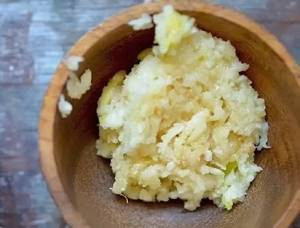
- Chop a fresh tomato and squeeze the juice of half a lemon.
- Place all these ingredients in a bowl, add mustard and soy sauce and mix well.
- Place the lamb in a deep bowl and pour the prepared marinade over it. Turn the meat over so that all sides are coated with marinade.
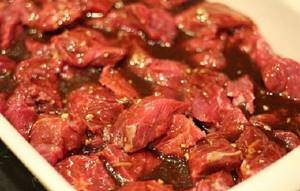
- Leave the lamb in the marinade for half an hour to marinate.
- After this time, wrap the lamb in foil and place on a baking sheet.
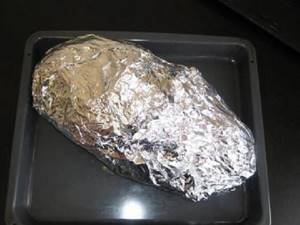
- Bake the meat in an oven preheated to 200°C for 1.5–2 hours. For 1 kg of lamb you need 1 hour of baking.
- Cut the baked lamb into portions and serve with fresh vegetables.
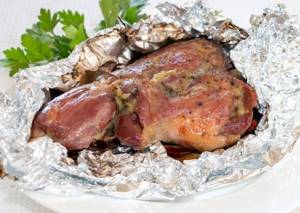
Eat for your health!
Lamb ribs are quickly fried, and vegetables and spices give them an unusual pleasant smell and taste. According to the proposed recipe, you can easily and simply prepare a dish from them for the family table. The ribs need to be pre-marinated. We bake them in the sleeve.
Ingredients:
- Lamb ribs – 1.7 kg.
- Potatoes – 8 pcs.
- Sweet pepper – 4 pcs.
- Eggplant – 2 pcs.
- Onions and carrots – 2 pcs.
- Mayonnaise – 3 tbsp. l.
- Salt and pepper - to taste.
- Rinse the lamb ribs well, dry with a kitchen towel, cut into portions and chop the bones in half.
- For the marinade, chop the garlic in a garlic sauce and mix it with mayonnaise. Add salt and pepper to this mixture to your taste.
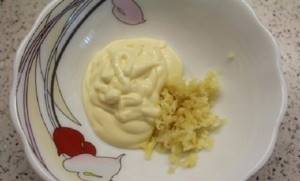
- Spread the ribs with the resulting garlic-mayonnaise mixture, place in a bowl, cover with a piece of cling film and leave to marinate for 3-4 hours.
- After this time, you can start preparing the dish.
- Peel and rinse all vegetables.
- Chop the onion into quarters and grate the carrots on a coarse grater. Fry these vegetables in heated vegetable oil until golden brown.
- Cut the peppers and eggplants (they can be replaced with zucchini) into medium cubes, add salt and mix.
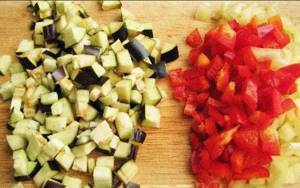
- Cut the potatoes into slices.
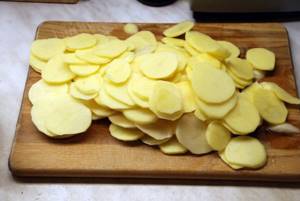
- Place chopped raw vegetables in a baking bag as the first layer.
- Place fried onions and carrots on them.
- Place the marinated ribs on top of the roast.
- Pour the juice from raw vegetables into a bag.
- Secure the ends of the bag with clips and pierce it in several places on top to allow hot air to escape during baking.
- Bake the ribs in the oven at 180°C for one and a half hours.
Bon appetit!
You can learn how to cook lamb in the oven deliciously, so that the meat is soft and juicy, using a proven recipe with step-by-step photos.
• lamb (any part) – 1.5-2 kg;• tomatoes – 2 pcs.;• soy sauce – 150 ml;• garlic – 3 cloves;• juice of ½ lemon;• mustard – 1 tsp;• mixture of peppers , spices and herbs to taste (and optional).
1. Rub the washed and dried meat with a small amount of salt (taking into account that salty soy sauce will be in the marinade), a mixture of peppers and spices.
2. If possible, before rubbing the meat with spices and salt, it is advisable to soak it overnight in salted water with lemon juice.
3. Continuing the cooking process, mix finely chopped tomatoes with crushed garlic in a container suitable for the given amount of meat. Add soy sauce, mustard and lemon juice to the marinade.
4. Place the lamb in the prepared container with the marinade and thoroughly rub the meat with it. We keep the meat in the marinade for an hour at room temperature.
5. Transfer the lamb along with the marinade to foil and wrap the meat thoroughly in it.
6. Bake the lamb for a couple of hours at 200°C, half an hour before the end of cooking, remove the baking sheet with meat, open the foil, take a sample and decide whether to continue cooking.
7. Serve the finished, aromatic lamb with chopped fresh vegetables and herbs.
Baked lamb
You can cook a delicious and satisfying dish in the oven. If a fatty piece of meat is used, it is not seasoned with oil, leaving it to bake in its own juices. Baked lamb is considered the ideal dish for any holiday table. The calorie content of 100 g of meat here will be no more than 250 kcal.
To prepare you need the following ingredients:
- lamb on the bone - 3 kg. (shoulders or ribs);
- garlic - 5-6 cloves;
- salt;
- two large onions;
- greens (for serving);
- pepper, mustard, bay leaf.
Wash and dry the meat, pound lightly. Break the bay leaf and stuff it into the lamb. Mix salt, cumin, mustard and pepper, chopped garlic and onion. Rub the resulting mixture onto the meat and put it in the refrigerator for 5 hours. When the lamb is marinated, it should be placed on a baking sheet or placed in a baking sleeve.
Place the meat in an oven preheated to 200 degrees and bake for 2-3 hours until cooked. The lamb is ready when it releases pale pink juice when pierced. Before serving, the dish is sprinkled with finely chopped herbs.
Baked lamb, whose calorie content (per 100 grams), without adding oil, is 190 kcal, goes perfectly with a side dish of sauerkraut or mashed potatoes. You can also serve a vegetable salad along with the meat.
The consumption of lamb has been described since ancient times. It is especially valued in the national cuisines of the peoples of the East. It is the basis for world-famous beshbarmak, shurpa, manti, pilaf and shish kebab. Thanks to its remarkable nutritional properties, it is widely used in modern cuisine for preparing a wide variety of soups and broths; it is also baked and fried on the grill and grill. The calorie content of lamb is relatively low - only 202.9 kcal per 100 g.
The whole truth about lamb: benefits, harm, calorie content, dietary supplements, recipes
Meat and meat dishes
06.08.2018
827
554
6 min.
Lamb is a type of meat that, unlike beef and pork, is not often found on the table.
However, this product has a lot of useful properties: it helps to improve your well-being, solve some health problems and bring your weight back to normal.
The low demand for sheep meat is explained by its specific taste. But if you know the nuances of proper preparation of lamb, you can create a real culinary masterpiece.
| Type of meat | Fat content per 100 g of product | Cholesterol content per 100 g of product |
| Lamb I category | 16.3 g | 70 mg |
| Lamb II category | 9.6 g | 70 mg |
| Pork | 33.3 g | 80-100 mg |
| Beef category I | 16.6 g | 80 mg |
| Beef category II | 9.8 g | 80 mg |
| Proteins, g | Fats, g | Carbohydrates, g |
| 16,3 | 15,3 |
| Type of fresh or processed lamb | Calorie content per 100 g, kcal |
| Fresh category I | 209 |
| Fresh category II | 166 |
| Roast | 320 |
| Shashlik | 290 |
| Stew | 270 |
| Grilled | 270 |
| Baked in the oven | 230 |
| Boiled | 230 |
The data from the table clearly proves that if you boil or bake a piece of lamb in the oven and supplement it with fresh or stewed vegetables, you will get a dietary lunch. This combination of products has benefits for both your figure and overall health.
Lamb fiber contains a lot of useful nutrients:
- vitamins – B1, B2, B5, B6, B9, B12, E, D, H, PP;
- microelements – tin, chromium, iodine, cobalt, manganese, nickel, fluorine, copper, molybdenum, zinc, iron;
- macroelements - sodium, magnesium, potassium, calcium, phosphorus, selenium, chlorine, sulfur.
Thanks to its rich vitamin and mineral composition, lamb has a beneficial effect on internal organs and the general condition of the body:
- helps in the treatment and prevention of iron deficiency anemia;
- improves the functioning of the central nervous system;
- normalizes the functioning of the gastrointestinal tract;
- supports various biochemical processes in the body;
- helps strengthen teeth, bones, hair and nails;
- prevents early skin aging;
- improves the functioning of blood vessels and the heart;
- serves as a means of preventing diabetes mellitus and atherosclerosis;
- mobilizes the body's defenses;
- activates the male reproductive system.
Lamb fat also has medicinal properties. It is used to treat colds accompanied by sore throat and cough. The meat of lambs aged 1-2 months is considered the most nutritious and soft.
Lamb is contraindicated for children under 3 years of age and the elderly. Doctors justify this ban by the fact that children and old people do not produce enough enzymes involved in the breakdown and absorption of this dietary product.
To avoid harm to the body, it is not recommended to indulge in dishes made from lamb meat for certain categories of patients with:
- slow or poor digestion;
- pathologies of the kidneys and gallbladder;
- increased acidity of gastric juice;
- ulcers of the stomach and duodenum;
- gout, arthritis and other joint diseases.
In case of the listed pathologies, it is necessary to follow a diet, from which it is necessary to exclude any types of meat.
Even if there are absolutely no contraindications to eating lamb, you should not replace it with other meat. A monotonous diet can lead to a lack of nutrients necessary to maintain the vitamin and mineral balance in the body.
You can prepare many delicious and healthy dishes from lamb meat. In Eastern countries, shurpa and shish kebab are considered traditional.
To create a culinary masterpiece from lamb with your own hands, you need to take into account the subtleties of heat treatment of meat.
Kebab prepared in nature can satisfy the taste of any gourmet. But if you can’t go out of town, you can make the dish in the oven.
To do this you will need:
- 1 kg of lamb meat;
- 2 onions;
- 350 g pork or fat tail fat;
- 1 lemon;
- 1 pinch each of red pepper, cumin, turmeric, ground coriander;
- salt to taste.
Cooking method:
- 1. Remove all films and tendons.
- 2. Cut the meat and lard into small pieces.
- 3. Place in a bowl or pan and coarsely grate the onion on top.
- 4. Add spices and freshly squeezed lemon juice, stir and marinate the meat for 1-2 hours.
- 5. In random order, string pieces of lamb and lard onto bamboo sticks or metal skewers.
- 6. Preheat the oven to 250°C.
- 7. Cover a baking sheet with food foil and place on the bottom shelf of the oven.
- 8. Place a wire rack on the middle level and place the skewers on it.
- 9. As it browns, turn the meat over to the other side so that it is evenly covered with an appetizing crust.
The lamb shish kebab recipe is simple and easy to make at home.
To prevent wooden skewers from burning due to high temperature, it is recommended to soak them in cold water half an hour before threading the meat.
It will take about 3-5 hours to cook a rich, healthy and clear broth. The result will exceed all expectations; the dish will delight you with its incomparable taste and aroma.
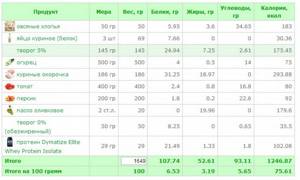
For 4-6 servings of lamb broth you will need:
- 2-3 liters of water;
- 0.5 kg of meat (shoulder, thigh or neck);
- 1 onion;
- 1 carrot;
- 1 head of garlic;
- 2 tbsp. l. table salt;
- spices to taste (black pepper, coriander, fennel);
- fresh herbs (basil, cilantro, green onions, parsley).
Cooking technology:
- 1. Cut the lamb into portions and soak in cold water for 1.5-2 hours.
- 2. Rinse the meat well to remove as much ichor, hairs and small debris as possible.
- 3. Place the lamb in a cauldron or saucepan and add water.
- 4. Place on the stove and turn on medium heat.
- 5. After the water boils, constantly remove foam and small floating particles.
- 6. An hour after the broth starts boiling, put whole peeled carrots and onions into the cauldron and cook for another 2 hours.
- 7. Add salt and spices, cook for another 1 hour.
- 8. Peel the garlic head, chop the cloves or crush them with a knife and add them to the broth.
- 9. Cook for another 30-40 minutes until fully cooked.
- 10. Pour the broth into plates, bowls or soup mugs, add a piece of meat and sprinkle with finely chopped herbs.
Cook the lamb broth over low heat. You should not add boiling water - this will result in a more rich and nutritious dish.
Meat and meat dishes
READ MORE: About the benefits of yoga for men
06.08.2018
9.9 thousand
6.6 thousand
6 min.
Dietary features of meat
Lamb is endowed with excellent culinary and nutritional properties due to its composition. It is rich in especially easily digestible proteins and various microelements. It contains a lot of potassium, sodium, calcium, magnesium and phosphorus. It is rich in vitamins B1, B2 and PP. However, if there are approximately the same amount of minerals and vitamins in lamb as in beef and pork, then in terms of the amount of iron it exceeds them by a third.
Lamb is healthier and lower in calories compared to lamb.
This meat is difficult to digest. Therefore, its use should be limited to people prone to digestive problems. However, even despite this, Eastern doctors recognize lamb as the healthiest of all types of meat.
Lamb meat is 3 times lower in fat content than pork meat and 2.5 times lower than beef meat. Therefore, dishes made from boiled lean lamb are often included in dietary menus.
Eating lamb meat for weight loss
To normalize the body's metabolism, which contributes to weight loss, you simply need to reduce the calorie content of the foods you consume. In order for the process of ridding the body of excess fat deposits to be started, you should not torture yourself with strict mono-diets of tasteless foods, you should just replace your usual foods with foods that contain fewer calories and do not overeat, especially in the evening.
When putting their body in order, many consciously refuse to eat meat, but you can simply replace it with dietary lamb, which can saturate the body with useful elements without harming the figure. For this approach, meat from the back of the carcass is best suited, since it contains the least fat deposits, but at the same time the content of nutrients and vitamins is higher.
Similar articles:
- Combined courses of steroids - SportWiki encyclopedia
- Short courses of steroids for mass, proven courses
- Harm of meat to the human body
- Sports supplements » Samyun Wan or Ginseng Kianpi Pil, the whole truth about capsules for mass gain
Beneficial properties of lamb
But lamb fat can also provide benefits to the body. For example, it is often used as one of the components of a remedy for sore throat, flu, ARVI and other colds. It is consumed hot.
To prepare such a remedy, dilute the following in well-heated milk:
- 1 tbsp. l. honey;
- 1 tbsp. l lamb fat.
This meat has virtually no cholesterol, but contains lecithin, which has an additional stimulating effect on the pancreas and helps break down cholesterol plaques. Thanks to this, metabolic processes in the body are normalized, which significantly reduces the risk of developing atherosclerosis.
Advice from nutritionist Irina Shilina
Pay attention to the latest weight loss method. Suitable for those for whom sports activities are contraindicated.
In addition, systematic consumption of this meat is a good prevention of heart disease, blood vessels and diabetes. This will be facilitated by the presence of sodium, magnesium, potassium salts and iron, and iodine helps normalize the functioning of the thyroid gland.
Broths made with this meat will be very useful for those who suffer from hypoacid gastritis (with reduced secretory function). A significant fluoride content will help prevent the risk of dental caries. However, you should use it very carefully if you have stomach and intestinal diseases (lamb fat is the most refractory and difficult to digest).
Losing weight representatives of the fair sex often neglect this valuable source of protein and minerals due to the specific smell. However, it can be easily removed by simply treating the meat with lemon juice or soy sauce with spices and herbs. And fresh lemon juice is added to the soup at the end of cooking the meat.
Lamb, calories | Healthy eating
Jan-31-2013 KoshkaS
Lamb is a wonderful, tasty variety of meat, which is considered a delicacy in a number of countries around the world.
It is included in a huge number of different culinary recipes, including dishes of the national cuisines of the peoples of the former Soviet Union, where lamb is one of the traditional products.
It is precisely because of the popularity that lamb enjoys that its calorie content, as well as its benefits and dietary properties, could not help but become the subject of interest of people accustomed to monitoring the energy value of food.
Dietary properties:
Lamb has excellent culinary and nutritional qualities. This is due to its composition. It is a rich source of easily digestible proteins and various chemical elements.
Lamb contains approximately the same amount of mineral components and vitamins as beef and pork. But in terms of iron content, it is about 30% ahead of pork.
Lamb contains minerals such as potassium, sodium, calcium, magnesium, and phosphorus. It contains vitamins - B1, B2, PP.
Lamb is a rather difficult to digest meat, so it should be consumed sparingly by those who have problems with the intestines and stomach. But at the same time, in Eastern medicine it is recognized as the best meat.
Lamb is 2-3 times lower in fat content than pork and 2.5 times lower than beef. Thanks to this feature, dishes made from boiled lean lamb can often be included in dietary diets.
Lamb fat is widely used as a remedy for colds (such as sore throat, flu, ARVI). At this point, dissolve a tablespoon of honey and lamb fat in hot milk and drink the resulting hot solution.
Lamb contains almost no cholesterol.
In addition, it contains the substance lecithin, which stimulates the functions of the pancreas and normalizes the processes of cholesterol metabolism in the human body.
This significantly reduces the likelihood of developing atherosclerosis. Regular inclusion of this type of meat in the diet is a good way to prevent diseases of the cardiovascular system.
Meat broths made from lamb will be useful for those who are susceptible to gastritis with low acidity.
And further:
Lamb is also much healthier in quality than pork.
- Eating lamb stimulates the activity of the pancreas and thus can serve to prevent diabetes.
- Lamb has anti-sclerotic properties and the ability to normalize cholesterol metabolism in the body.
- The large amount of fluoride contained in lamb will help protect teeth from caries.
- The presence of sodium, magnesium and potassium salts has a beneficial effect on the functioning of the cardiovascular system.
- Lamb contains a lot of iron, which is necessary for the process of hematopoiesis.
- Iodine normalizes the functioning of the thyroid gland.
- The permissible daily dose of lamb is 50 g.
Damage to lamb
Lamb should not be consumed:
- people with gastrointestinal tract disease (since lamb cholesterol is the most refractory and very difficult to digest);
- Consumption of lamb should be limited in the warm season.
Despite the fact that representatives of the fair half of humanity, due to the unique aroma and specific taste qualities, often neglect this type of meat, lamb has been and remains a very healthy product, a source of protein.
Well, what exactly is the energy value of this product? And here it is:
The calorie content of lamb is 203 kcal per 100 grams. product
What is the calorie content of lamb cooked in different ways? And here it is:
Lamb calorie table, per 100 grams of product:
| Product | Calories, in kcal |
| boiled | 291,0 |
| stewed | 268,0 |
| baked | 231,0 |
| Grilled | 264,0 |
| fried | 320,0 |
And the nutritional value of lamb cooked in different ways is as follows:
Table of nutritional value of lamb (BZHU), per 100 grams of product:
| Product | Squirrels, gr. | Fats, gr. | Carbohydrates, gr. |
| boiled lamb | 24,6 | 21,4 | 0,0 |
| stewed | 20,0 | 20,0 | 0,0 |
| baked | 17,0 | 18,0 | 0,7 |
| Grilled | 26,2 | 16,0 | 4,0 |
| fried | 20,0 | 24,0 | 0,0 |
What can you cook from this meat at home? Here is one of the recipes:
Baked lamb:
Products:
- Leg of lamb
- Carrot
- Garlic
- Dry wine
- Celery root
- Spices
The leg of lamb is washed and the chaff is removed. Then it is stuffed with garlic and carrots. Grease a baking tray with fat, lay out a leg of lamb, rub it with salt and spices. Then it is covered with carrots and celery.
½ glass of dry wine is poured and diluted with water, then poured into a baking tray. Cover the baking sheet with foil and place it in the oven, preheated to a temperature of 200 C. The meat is baked for 2 - 2.5 hours.
When the lamb is ready, remove the foil and leave the pan in the oven for another 15 minutes.
Done - enjoy the result! And don’t let the relatively high calorie content of lamb spoil your figure!
Lamb products for weight loss
In order to remove extra pounds from the waist, abdomen and hips, the best option would be to reduce your daily caloric intake. And to do this, you don’t need to renounce traditional, favorite dishes and limit yourself to strict diets. It will be sufficient to simply replace high-calorie foods with less energy-intensive ones.
However, many girls completely refuse meat products, considering them too high in calories. This strategy will not be beneficial, but if you replace regular types of meat with dietary lamb, your weight will return to normal and your body will not lack protein. Moreover, if you definitely decide to get rid of those annoying extra pounds, preference should be given to meat from the back of the animal, which contains significantly less fat and the maximum amount of nutrients, minerals and vitamins.
The method of preparation is also important, because even the most dietary product cooked in fat will lose its beneficial qualities and will only increase fat deposits. The best way to cook meat for weight loss is boiling. Moreover, properly boiled lamb has no odor, has a pleasant taste, has the lowest calorie content and retains almost all its beneficial qualities.
Different varieties of this meat can be cooked in the oven, on the grill or on the grill, but you should not use oil when frying, which significantly increases the calorie content of lamb. Naturally, there is no “lamb” diet, since this product itself does not imply significant weight loss from its use. But if you don’t discount the low calorie content of lamb, it will be an excellent substitute for boiled, stewed and baked pork or beef, and it contains more than enough useful substances.
There is definitely a point in using this product with the goal of losing weight.
Sheep were domesticated by Asian nomads approximately 10 thousand years ago. Today, the tasty meat of these animals is used to prepare many dishes, especially since the calorie content of lamb is not too high.
Lamb - composition, benefits, harm and nutritional value
For many, lamb is a national product, on the basis of which hundreds of traditional dishes are prepared. People who monitor their diet and take into account not only the energy value, but also the beneficial qualities of the product, are accustomed to seeing lamb on their table.
This type of meat is very popular due to its dietary properties.
In any product, its composition is valued, or, more precisely, the presence of vitamins and beneficial microelements. Also, do not forget about the nutritional value of the product, that is, the concentration of proteins, fats and carbohydrates in it.
This table contains information on BJU per hundred grams of meat prepared in various ways.
As for the KBJU product, the energy value of 100 grams of fresh lamb is 209 kcal. Just like BJU, calorie content can change with different options for preparing the product.
Changes in calorie content with different types of heat treatment of lamb leg.
Lamb heart is considered the leanest option: it contains only 82 kcal per hundred grams. The tongue is also very useful (it contains 195 kcal), the ribs contain 203 kcal, but they are still considered dietary compared to other parts of lamb, because the shoulder has 380 kcal, the back has 460 kcal, and the breast has 533 kcal.
Among the various types of lamb, Kalmyk sheep meat stands out, which is considered more useful than other varieties. It does not have a specific smell, but it contains an order of magnitude more useful vitamins and chemical elements than the meat of other sheep breeds.
READ MORE: Body drying for girls as a method of losing weight weekly menu at home
Lamb is very rich in vitamins D, E, K, B1, B12, B2, B9, B5, B6, PP.
It also contains minerals such as iron, phosphorus, manganese, sodium, magnesium, potassium, silicon, selenium, nickel, fluorine, calcium, cobalt, tin, zinc, iodine, molybdenum, chlorine, chromium, sulfur and copper.
Important
Due to the large amount of iron, lamb is recommended to be eaten for anemia and low hemoglobin levels. This type of meat stimulates the pancreas well and prevents the development of diabetes.
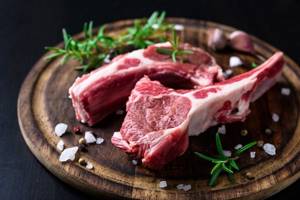
But even such a healthy product as lamb should not be consumed if you have problems with the kidneys, gall bladder and liver. Due to the fairly high fat content, complications are possible, so doctors recommend limiting the consumption of this product. Lamb is also contraindicated in case of impaired digestion and the following diseases:
- arthritis;
- ulcer;
- gastritis;
- heart problems;
- increased stomach acidity.
If you abuse lamb, these diseases can progress, because this meat contains a large amount of cholesterol. Lamb is also not recommended for children and the elderly. In addition, even a healthy adult is better off not eating it every day, as this can lead to atherosclerosis.
In addition to lamb, another type of meat should be present in a person’s complete diet. Otherwise, if you consume lamb exclusively, this will lead to its negative effects on the body. Studies have shown that lamb meat contains virtually no iodine, which leads to problems with the thyroid gland.
Lamb meat contains quickly digestible proteins that saturate the human body with amino acids. But, despite all the beneficial properties, this meat takes a very long time to digest and is considered heavy food. Although, according to oriental medicine, lamb is the most acceptable type of meat for humans, and you need to eat fifty grams of this product in any form per day.
For those watching their figure, there is no better meat, because its calorie content is half that of beef and about three times less than that of pork. Doctors strongly recommend replacing any meat with lamb during the dietary period. Do not forget that it is lamb fat that helps with influenza, viral and infectious diseases.
Regular consumption of lamb has the following effects on the human body:
- prevention of diabetes mellitus;
- stimulation of the proper functioning of the pancreas;
- strengthening tooth enamel and preventing caries due to the high fluoride content;
- cleansing and restoration of the cardiovascular system;
- a high concentration of iron has a positive effect on hematopoiesis.
In pursuit of a slim body, meat is sometimes completely excluded from the diet, but the only thing worth doing is replacing it with lamb. Naturally, eating red meat does not guarantee weight loss, because no one has heard of the “lamb” diet, but by replacing pork or beef with lamb, you can significantly reduce your daily calorie intake.
For weight loss, it is better to choose the back part of the carcass: it does not have much fat and enough vitamins.
Special attention should be paid to the method of preparing meat, because even a dietary product can lose its properties if improperly processed.
- Try to avoid fried red meat, as this processing significantly increases the amount of carcinogens. If you really want fried lamb, then before frying, remove all fat from the product and avoid using an open flame.
- The most dietary way to cook lamb meat is to stew it over low heat.
- Lamb can also be boiled; this method of heat treatment will preserve its taste, but will reduce calories to a minimum.
- Be sure to marinate red meat, because marinade makes it healthier and tastier. And if you use the right ingredients for the marinade, this will reduce its calorie content several times.
For information on how to cook lamb shoulder with potatoes in the oven, see below.
In addition to the composition of vitamins and various chemical elements, the calorie content of the product is also of great importance. In its pure form, the calorie content of lamb is 203 kcal per 100 grams of product, but with different heat treatments and serving methods, the calorie content of the dish in its pure form tends to change.
- boiled – 291.0 calories;
- baked – 232.0 calories;
- stewed – 268.0 calories;
- fried – 320.0 calories;
- grilled - 264.0 calories.
If we talk about the nutritional value of lamb (bzhu), then with the help of a visual table you can understand what the body is saturated with when eating a dish prepared by various methods of heat treatment.
| Lamb nutritional value per 100 grams | |||
| Type of lamb preparation | Squirrels | Fats | Carbohydrates |
| Boiled | 24.6 g | 21.4 g | 0.0 g |
| Baked | 17.0 g | 18.0 g | 0.7 g |
| Stewed | 20.0 g | 20.0 g | 0.0 g |
| Fried | 20.0 g | 24.0 g | 0.0 g |
| Grilled | 26.2 g | 16.0 g | 4.0 g |

